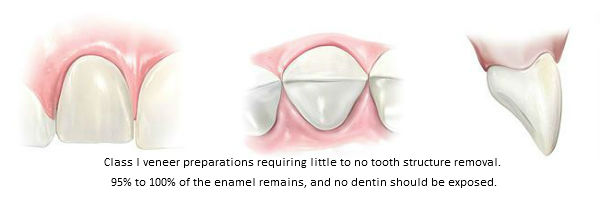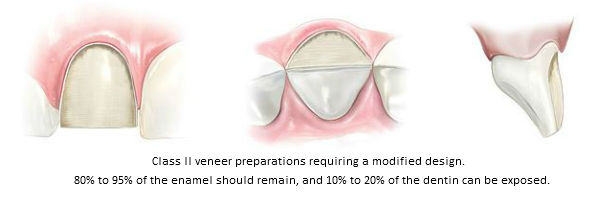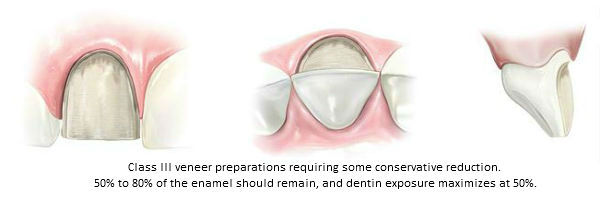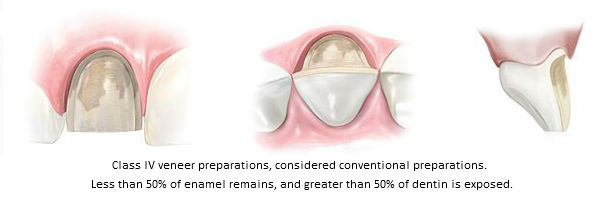Your natural teeth will probably require some preparation before you receive porcelain veneers. Why? Because preparing your teeth conservatively can help achieve healthy, esthetic results for your teeth and gums. But tooth preparation should never be aggressive. Dr. Brian LeSage is an Accredited Fellow of the American Academy of Cosmetic Dentistry, sensitive to your concerns about preparing your teeth for veneers.
Dr. LeSage’s Approach
While many dentists are fairly aggressive in how much tooth structure they remove before placing porcelain veneers, Dr. LeSage believes in a conservative, minimally invasive approach. He believes it is important to leave as much of your natural tooth enamel as possible and only reduce 0.3 mm to 0.5 mm of tooth enamel.
A Classification System for Veneer Preparation
Not all dentists remove the same amount of tooth structure in preparation for porcelain veneers. As a patient, you don’t know what to expect unless your dentist tells you how much enamel will be removed. And a comparison would help you understand how the preparation will affect your natural teeth. Dr. LeSage has developed and published his Classification System and Criteria for Veneer Preparation.
- Update to Preparation Design 1 and Clinical Concepts Using the LeSage Veneer Classification System, Journal of Esthetic and Restorative Dentistry Volume 32, Issue 2, February 25, 2020, LeSage, Brian P
- Establishing a Classification System and Criteria for Veneer Preparations, Compendium of Continuing Education in Dentistry June 2019 RN, Brian LeSage, DDS
- Summary of the above article on veneer preparation from PubMed.
He includes four classifications to clarify how much tooth enamel remains after preparation, as well as how much dentin (the layer beneath the enamel) is exposed.
Class I – No-preparation or practically prep-less veneers: 95% to 100% of enamel volume remains. It is best to determine a finish line to provide a perfectly smooth margin between the porcelain and the tooth. Otherwise, there will be a bump where the porcelain begins. But so little enamel is removed with Class I preparation that the finish line may only be visible under magnification. Dr. LeSage considers this the ideal preparation.
Class II – Minimally invasive or modified prep-less veneers: 80% to 95% of enamel volume remains, and 10% to 20% of dentin is exposed. In some cases, because of tooth position or shape, the ideal Class I preparation isn’t practical. Class II, a slightly less conservative option, is used instead.
Class III – Conservative preparation: 50% to 80% of enamel volume remains, and 20% to 50% dentin is exposed.
Class IV – Conventional preparation: Less than 50% of enamel volume remains, and greater than 50% of dentin is exposed. Unfortunately, this veneer preparation type has become almost universally accepted for placing full veneers. But with so much enamel removed, the strength of the veneers is compromised and their lifespan is shortened.
Why Enamel Matters
If a porcelain veneer completely covers the front of your tooth, why should you be concerned about a classification system for veneer preparation? The amount of tooth enamel that remains after veneer preparation matters. There are many reasons for concern, and some include:
- Dental resin cement adheres better to enamel than to dentin.
- A bond to tooth enamel is more reliable, and it lasts longer.
- When veneers are bonded to dentin instead of enamel, it increases the risk of the bond becoming weak. Porcelain is thin and gets its strength from the bond to the tooth. When that bond weakens, a porcelain veneer can crack or loosen and fall off.
- Bonding to dentin increases the risk of microleakage. Bacteria can seep in and affect the unprotected dentin. Microleakage can cause a veneer to darken at the margins where new decay can develop.
Regardless of which cosmetic dentistry treatment you receive, Dr. LeSage’s goal is to preserve as much healthy tooth structure as possible. For porcelain veneers, he prefers Class I or Class II preparation, leaving a minimum of 80% or more of your tooth enamel intact. Your veneers will be beautiful and stable, and your natural teeth behind them will be healthy and protected. You deserve a healthy, long-lasting smile makeover. Read details about what to expect when you receive porcelain veneers from Dr. LeSage.






